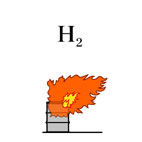| Case Name |
Leakage and fire of hydrogen caused due to stress corrosion cracking that originated from the influence of turnaround shutdown maintenance on a drain valve at hydrogen gas piping in a fuel oil desulfurization cracking unit |
| Pictograph |

|
| Date |
January 13, 1977 |
| Place |
Kawasaki, Kanagawa, Japan |
| Location |
Refinery |
| Overview |
On July 3rd, 1999. Hydrogen leaked suddenly from hydrogen heating furnace outlet piping of the fuel oil desulfurization cracking unit during usual operation at the refinery, and a fire occurred. Dilution water for cleaning polythionic acid collected in the drain nozzle after a turnaround shutdown. The chloride concentration was high because the concentration in industrial water was originally high. The chlorine in industrial water was concentrated by a high temperature after starting operation, and stress corrosion cracking occurred. Hydrogen leaked, and a fire broke out by ignition from static electric sparks or heat. |
| Incident |
A fire occurred at the fuel oil desulfurization cracking unit of a refinery. 257 hours had passed from startup after a turnaround shutdown, and usual operation was carried out. The stress corrosion cracking was generated at drain valve connection piping located upstream an emergency shutoff valve at the outlet of a hydrogen heating furnace, hydrogen leaked, ignited, and a fire occurred. The designed operating temperature of the unit was 538 °C. Refer to Fig2. |
| Processing |
Manufacture |
| Individual Process |
Maintenance |
| Chemical Reaction |
Other (Hydro-desulfurization) |
| Substance |
Hydrogen, Fig3 |
| Type of Accident |
Leakage, fire |
| Sequence |
On July 3rd, 1999, 22:15. An operator on routine patrol found flames coming out near the emergency shutoff valve at the hydrogen gas heating furnace (F-102) outlet of the fuel oil desulfurization cracking unit. It was reported to the control room immediately.
22:17. Emergency shutdown operation of the unit was carried out. The heating furnace (F-102) was shut down.
22:27. An emergency call was made. The self-defense disaster prevention organization was set up.
22:35. The private fire brigade started fire extinguishing activities. The public fire brigade arrived.
23:56. The fire-extinguishing activities stopped.
On July 4th, 00:14. Flames were seen again coming from heat insulation of piping between the check valve and the emergency shutoff valve.
00:18. Fire extinguishing work using steam started.
01:01. The fire was confirmed to have been extinguished. |
| Cause |
At turnaround shutdown, the desulfurization cracking reactor was neutralized and washed with a polythionic acid aqueous solution. The Polythionic acid aqueous solution remained at the bottom of the check valve after flowing out from the drain valve. On starting operation, the remaining polythionic acid aqueous solution accumulated at the drain nozzle of the reactor inlet piping. On introducing high-temperature hydrodesulfurization gas, moisture evaporated, and chlorine became concentrated. The temperature in the drain nozzle also rose to the temperature at which stress corrosion cracking (SCC) could be generated. SCC was generated at a part with high stress, and hydrodesulfurization gas leaked. The cause of ignition was considered to be static electricity sparks during blowing or leaking of high-temperature gas into the atmosphere. The main component of the leaking gas was hydrogen, which has low ignition energy.
Although the material of the drain piping was austenite stainless steel which could generate SCC, it is sufficient material for usual operation and it does not cause any problem if pure water is used for polythionic acid treatment. |
| Countermeasures |
1. The dilution water for making a polythionic acid aqueous solution was changed from industrial water to pure water to lower the chloride concentration in the piping.
2. Gathered water in the drain was removed before heating work. Steam tracing was strengthened to prevent condensation of moisture.
3. The gusset was remodeled to have a structure in which thermal expansion is not restricted. |
| Knowledge Comment |
Sufficient management is necessary for stress corrosion in hydrogen piping because it can be a direct cause of an accident. The chlorine concentration can be high in industrial water. It is desirable to avoid treatment using water with a high chloride concentration. |
| Background |
Industrial water was used to dilute the polythionic acid. Therefore, the chloride concentration was high in the polythionic acid aqueous solution that accumulated in the drain valve nozzle. In addition, the chlorine was concentrated by the evaporation of water due to high temperature after starting operation, and SCC occurred. Water management using industrial water is a basic factor, though there was a possibility of SCC due to chlorine.
The stress was generated by thermal expansion at the gusset supporting drain piping by a temperature rise after starting operation. There might have been a design error related to the support. |
| Reason for Adding to DB |
Example of leakage and fire caused due to stress corrosion at hydrogen piping |
| Scenario |
| Primary Scenario
|
Poor Value Perception, Poor Safety Awareness, Inadequate Risk Recognition, Insufficient Analysis or Research, Insufficient Practice, Lack of Imagination, Carelessness, Insufficient Precaution, Carelessness of Planner, Planning and Design, Poor Planning, Poor Planning of Washing, Usage, Maintenance/Repair, Wrong finishing, Bad Event, Chemical Phenomenon, Concentration, Failure, Fracture/Damage, Cracking, Secondary Damage, External Damage, Leakage/Fire
|
|
| Sources |
Kawasaki City Fire fighting station. Prevention division. Peace section. Leakage and fire at hydrogen gas piping. Material of the Kawasaki City complex safety countermeasures committee. (1999)
|
| Physical Damage |
Heat insulation of piping was destroyed by fire. About 74 kg of gas for hydrodesulfurization burned. |
| Financial Cost |
¥ 200,000 (Material of the Kawasaki City complex safety countermeasures committee) |
| Multimedia Files |
Fig2.Figure showing situation
|
|
Fig4.Chemical formula
|
| Field |
Chemicals and Plants
|
| Author |
DOBASHI, Ritsu (School of Engineering, The University of Tokyo)
TAMURA, Masamitsu (Center for Risk Management and Safety Sciences, Yokohama National University)
|
|